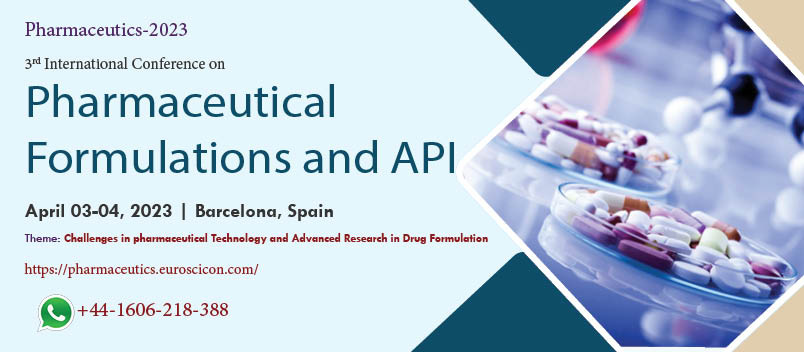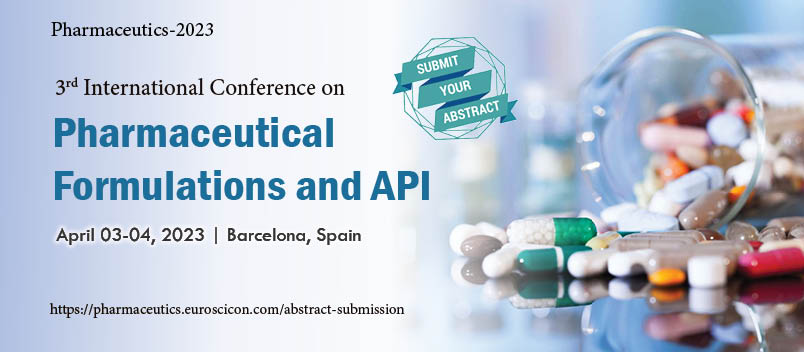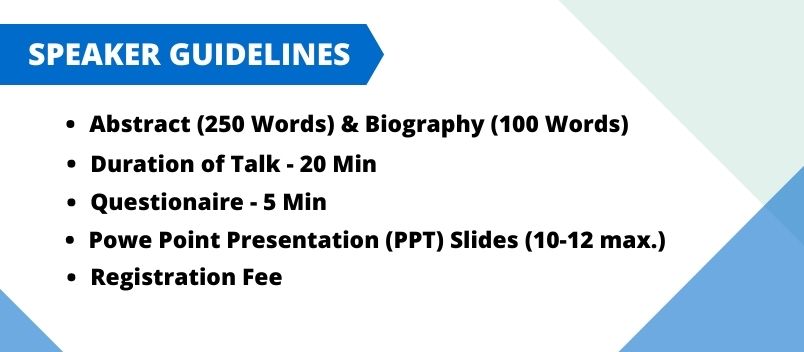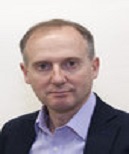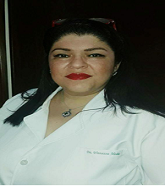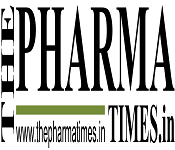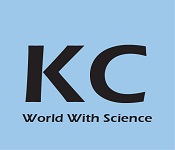PHARMACEUTICS-2023
About Conference
Welcome…!!!
After a successful conference of Pharmaceutics 2022 EuroSciCon Conferences announces its "3rd International Conference on Pharmaceutical Formulations and API" (Pharmaceutics-2023) scheduled during April 03-04, 2023 at Barcelona, Spain. Pharmaceutics-2023 aims at sharing new ideas and technologies amongst the professionals, industrialists and students from research areas of Formulation Design and Drug Delivery to share their recent innovations and applications and indulge in interactive discussions.
Hear, learn and explore the Latest Research involved in the field of Pharmaceutical Sciences.
Benefits of Attending:
This Programme features a blend of content tackling legal, commercial and technical topics & offers in-depth insights.
Exhibitor Showcases
Exhibitors educate the industry about their newest products.
Business Matchmaking
This is a powerful & effective tool allowing you arrange meetings with exhibitors prior to the event.
- Exchange ideas and network with leading healthcare experts, Pharmaceutical researchers, Drug Development and Discovery Companies, Formulation Scientists, Professors, Public health professionals and researchers from more than 40 countries.
- Discuss ways to collaborate in putting quality initiatives in place throughout the Pharmaceutics and Pharmaceutical Technology
- Participants can gain direct access to a core audience of professionals and decision makers and can increase visibility through branding and networking at the conference.
- Learn and discuss key news and challenges with senior level speakers.
- With presentations, panel discussions, roundtable discussions, and workshops, we cover every topic from top to bottom, from global macro issues to strategies to tactical issue.
Target Audience:
- Pharmaceutical & Biotechnology Companies
- Drug Delivery Scientists
- Product Development Specialists
- Formulation / Pre-Formulation Scientists
- Structure and Informatics Professionals
- Pharmaceutical Development Experts
- PK / PD Scientists
- Medicinal Chemists
- External Manufacturing Companies
- Scientists & Biotechnology Experts
- Academicians, Researchers & Students
- Nano Science and Nano Technology Researchers
- Pharma and Drug Delivery Associations and Societies
- Pharmaceutical Researchers
- Directors, Presidents, CEO's of Organizations/Companies
- Noble Laureates in Health Care and Medicine
- Medical Devices and Pharmaceuticals Companies
- Tool and Materials Companies
Who should attend?
Scientists and researchers related to the broad areas of Pharmaceutical Sciences, Pharmaceutical Researchers, Formulation Scientists, are most likely to attend Pharmaceutics 2023 and utilize the scope of extending their skills, and their work on basic and significant applications. The Pharmaceutics 2023 conference will be useful to participants from both Industrial as well as Academic fields in all the domains of Health care sectors.
Why to attend?
Pharmaceutics 2023 conference brings together experts, leading researchers, scholars, scientists, professors from fields of Health care, Pharmaceutical Sciences, Researchers and other related areas to interact and exchange ideas about the state of the art technologies related to Pharmaceutics and Pharmaceutical Technology. The conference will also provide an insightful understanding to the issues arising out of the Pharmaceutics and Pharmaceutical Technology and the future concern and remedies from that. Pharmaceutics 2023 conference provides an opportunity to interact with eminent Scientists, researchers, Business Leaders, experts from all over the world.
Key Takeways:
- CPD Accreditation Credits
- Professional Worldview
- Global Recognition of Scholars
- Emerging and Cutting-Edge Technologies
- Publication of Abstracts in Conference Proceedings
- Deep Learning and Sharing knowledge
- Exposure to the Upcoming Business Trends
- Supporting Communications Between Scholars
- Assessing the Research and Communication of Research Discoveries
- Participation Certificate with International Signatories
- Discover, Deliver and Delight
Pharmaceutical Societies and Associations:
Drug Information Association (DIA) | International Society for Biological and Environmental Repositories (ISBER) | The BioIndustry Association (BIA) | EuropaBio | The Pharmaceutical Research and Manufacturers of America (PhRMA) | The International Society for Pharmaceutical Engineering (ISPE) | The European Federation of Pharmaceutical Industries and Associations (EFPIA) | The American Association of Pharmaceutical Scientists (AAPS) | The Association of the British Pharmaceutical Industry (ABPI) | Medicines for Europe | The Association for Accessible Medicines (AAM) | European Personalised Medicine Association (EPEMED) | The International Federation of Pharmaceutical Manufacturers & Associations (IFPMA) ​| Medicines Australia | Innovative Medicines Canada | Life Sciences Ontario | Interfarma | Cámara Argentina de Especialidades Medicinales (CAEMe) | Federacion de Laboratorios Farmacéuticos Centroamericanos (FEDEFARMA) | China Pharmaceutical Industry Association (CPIA) | China Association of Enterprises with Foreign Investment (CAEFI) | Alliance pour la Reserche et l'Innovation des Industries de Sante (ARIIS) | Union des Industry Chimiques Pas de Calais | Biotech within Research-Based Pharmaceutical Companies (VFA-Bio) | Research-Based Pharmaceutical Companies (VFA) | Association of Representatives of Ethical Pharmaceutical Companies | Organization of Pharmaceutical Producers of India (OPPI) | Assobiotec | Japan Pharmaceutical Manufacturers Association (JPMA) | Maroc Innovation Sante (MIS) | Pharmaceutical Industry Association (LMI) | Asociación Nacional de Laboratorios Farmaséuticos Peruanis (ALAFARPE) | Association of International Pharm Manufacturers (AIPM) | Innovative Pharmaceutical Association South Africa (IPASA) | LIF Läkemedelsindustri föreningen | Association des entreprises pharmaceutiques en Suisse (VIPS) | Syndicat des Entreprises Pharmaceutiques Innovantes et de Recherche (SEPHIRE) | European Chamber of Commerce in Vietnam | Cámara Venezolana del Medicamento (CAVAME) | Biotechnology Innovation Organization (BIO) | Pharmaceutical Industry Neurology Group (PING)
SESSIONS AND TRACKS
Track 1: Pharmaceutical Sciences and Research
Pharmaceutical Sciences is a dynamic and interdisciplinary field that aims to integrate fundamental principles of physical and organic chemistry, engineering, biochemistry, and biology to understand how to optimize delivery of drugs to the body and translate this integrated understanding into new and improved therapies against human disease.
Pharmaceutical Scientists give papers that describe revolutionary research spanning the complete spectrum of drug discovery, development, evaluation, and regulatory approval. Small drug molecules, biotechnology merchandise together with genes, peptides, proteins and vaccines, and genetically engineered cells are a fundamental part of papers posted here. The current emphasis of the journal consists of the following areas: pre-formulations; drug shipping and focused on; components design, engineering, and processing; pharmacokinetics, pharmacodynamics, and pharmacogenomics; molecular bio-pharmaceutics and drug disposition; and computational bio pharmaceutics, among others.
- Drug Design and Drug Discovery
- Formulation Design and Pharmaceutical Technology
- Pharmacokinetics (PK), Pharmacodynamics (PD) and Systems Pharmacology
- Translational Research and Individualized Medicines
- Pharmacy Practice Research
Track 2: Drug Discovery and Development
A drug goes from being an idea in the lab to something that a doctor prescribes. To do this, it must go through a long development and approval process. During this process, researchers make sure the drug is safe for people to take and effectively treats cancer. This process often takes many years and significant resources. But the actual amount of time and money needed depends on the drug.
There are 3 main steps in finding and developing a new drug:
- Preclinical research, which is when the drug is found and first tested
- Clinical research, which is when the drug is tested in people
- Post-clinical research, which takes place after the drug is approved
Track 3: Pharmaceutical Formulation
Pharmaceutical formulation, in pharmaceutics, is the process in which different chemical substances, including the active the drug, are combined to produce a final medicinal product. The word formulation is often used in a way that includes dosage form.
Track 4: Pharmaceutical Pre-Formulation and Formulation Development
Formulation development studies determine the optimal dosage form, composition and manufacturing route is a fundamental part of pharmaceutical product development. Getting pharmaceutical formulation development right helps to optimise drug delivery performance and product stability. Complex dosage forms, in particular, inhaled and nasal products can present unique challenges for controlling the performance of the drug product and impact bioavailability. Solid, semi-solid and liquid formulations are developed using pre-formulation data to design prototype formulations and processes. The formulation development centre also has its own validated stability chambers to conduct lab stability tests to support selection of a suitable formulation and manufacturing process
Track 5: Novel Drug Delivery System
Drug delivery is the process of administering the drug or pharmaceutical product, in order to achieve the desired therapeutic effect. The method by which drug delivered is important, as it has a significant effect on its efficacy. Novel drug delivery system involves various approaches like medical devices or drug-device combination products. Novel drug delivery system (NDDS) involves combining polymer science, pharmaceutics and molecular biology.
To minimize drug degradation and loss to prevent harmful side-effects and to increase drug bioavailability and the fraction of the drug accumulated in the required zone, various drug delivery and drug targeting systems are currently under development. Among drug carriers one can name soluble polymers, micro particles made of insoluble or biodegradable natural and synthetic polymers, microcapsules, cells, cell ghosts, lipoproteins, liposomes, and micelles. The carriers can be made slowly degradable, stimuli-reactive (e.g., pH- or temperature-sensitive), and even targeted (e.g., by conjugating them with specific antibodies against certain characteristic components of the area of interest). Targeting is the ability to direct the drug-loaded system to the site of interest. Two major mechanisms can be distinguished for addressing the desired sites for drug release: (i) passive targeting(ii) active targeting.
Track 6: Pharmaceutical Nanotechnology
Medication conveyance characterizes as the best approach to take pharmaceutical from the diverse course of organization show in a human body and in addition creature. At the point when the medication is gone into human or creature body begins to demonstrate some helpful impact, which mends our body, experience the ill effects of particular infection or sick. Medication will begin go from pharmacokinetics frame work which contain adsorption, digestion, dissemination and discharge and after that goes into the circulatory framework, where the particular medication reach to particular receptors and tie with the receptors, which begin recuperate to body. Medication conveyance has done from various course, e.g.; oral course, intravenous course, intramuscular course, transdermal patches, intraocular course, intra-peritoneal, suppositories, and so on targeted delivery. Nanoparticle formulation, Nano medicine delivery and inhalation aerosols, Self-emulsifying drug delivery system, Oral and parental drug delivery.
- Nano medicine And Biomedical Applications
- Nano particulate Drug Delivery Systems
- Nanoparticle Delivery of Non-Coding RNAs
- Nanoparticle Fabrication
- Big Data To Help Nanotechnology
- Clinical Translation Of Nanotechnology
- Nanoparticles for Immuno-Oncology and Screening.
Track 7: Formulation Design and Pharmaceutical Technology
All pharmaceutical products are formulated to specific dosage forms for drugs to be effectively delivered to patients. Typical pharmaceutical dosage forms include oral tablets, capsules, solutions, suspensions, topical ointments, gels, and solutions, and injections for intravenous (IV), intramuscular (IM), or subcutaneous (SC) administration. In addition, various drug delivery systems have been developed for transdermal, intranasal, and pulmonary deliveries. Different dosage forms require different pharmaceutical technologies and usually present different technical challenges for formulation development.
Because of the complex technical challenges scientists encounter during formulation development, it is important to use an effective methodology. Design of experiments and statistical analysis have been applied widely to formulation development, and are useful in process optimization and process validation. The major advantage of using Design of experiments to develop formulations for pharmaceutical products is that it allows all potential factors to be evaluated simultaneously, systematically, and quickly.
Track 8: Industrial Pharmacy
Industrial Pharmacy also plays a crucial role in any drug discovery. To any novel drug discovery the industrial approach is very important to get massive commercial application. Few things which have to be considered by industries to provide a safe and cost affective medicine to the patients like Supply chain, Waste management, Product management, Post- marketing surveillance, Good manufacturing practices and Marketing.
The U.S. pharmaceutical market is the world’s most important national market. Together with Canada and Mexico, it represents the largest continental pharma market worldwide.
- Waste management
- Product management
- Post- marketing surveillance
- Good manufacturing practices
Track 9: Pharmacokinetics and Pharmacodynamics in Drugs
Pharmacokinetics is currently defined as the time study of drug absorption, distribution, metabolism, and excretion. Clinical pharmacokinetics is the application of pharmacokinetic principles to the safe and effective therapeutic administration of drugs in an individual patient. The primary goals of clinical pharmacokinetics are to increase the effectiveness of the patient's drug treatment and to reduce toxicity. The development of strong correlations between drug concentrations and their pharmacological responses has enabled clinicians to apply pharmacokinetic principles to real patient conditions.
Track 10: Pharmaceutical Analysis
Pharmaceutical analysis is a branch of practical chemistry that involves the series of process of identification, determination, qualification and purification of a substance, separation of the components of a solution or mixture, or determination of structure of chemical compounds. Pharmaceutical analytic studies uses instruments and methods used to separate, identify and quantify matter. In practice, separation, identification or quantification may constitute the entire analysis or be combined with other method. Separation isolates analytes, while quantitative analysis determines the numerical amount or concentration, and qualitative analysis determines the quality of product.
- GMP method development and validation
- Drug analysis
- Spectroscopy and its techniques
- Modern technologies used in analysis
- Bio analysis
- Quality assurance and quality control
Track 11: Pharmaceutical Chemistry
Basically, it consists of assorted pieces of identifiable proof, and then an efficient, intensive engineered transformation of new fictitious elements to make them suitable for restorative use. This includes specialist research being developed on the engineering and computational components of existing drugs and their bioactivity, i.e. understanding their structure-action connections (SARs). Science is centered on the quality components of the solution and well-being is guaranteed due to restorative factors.
- Protein structure prediction and molecular simulation
- Biochemistry
- Exploratory development
- Complementary medicine
- Protein structure prediction and molecular simulation
Track 12: Pharmaceutical Engineering
Pharmaceutical engineering is branch of engineering focused on Discovering, Manufacturing and formulating the medications. This includes designing and operating the machines, determining product presentation, designing and packaging of labels. This mainly consists of a data that is related to devices used in pharmaceutical industry.
- Biomedical Industries
- Biopharmaceutical Plants
- Production and quality systems
- Drug Tolerance
- Designing quality drugs for diseases
- Significance and scope
Track 13: Pharmacology & Toxicology
Clinical pharmacology, cardiovascular pharmacology, behavioral pharmacology, neuropsychopharmacology, pharmacogenomics and pharmacoeconomics are just a few of the many sub-specialties of pharmacology.
Toxicology studies the negative consequences of pharmaceuticals and chemical substances as well as treatment options, while pharmacology studies the positive effects of drugs.
Track 14: Process Validation
Process validation is defined as the collection and evaluation of data, from the process design stage throughout production, which establishes scientific evidence that a process is capable of consistently delivering quality products.
- Prospective Validation This type of validation is performed before production, during a product's development stage
- Concurrent Validation
- Retrospective Validation
- Revalidation
Track 15: Toxicology Approaches in Drug Discovery
The field of toxicology has changed significantly over the last decade, toxicology experts are stepping away from traditional techniques and are shifting towards novel methods for assessing toxicity. More specifically, they are embracing the advancing areas of cell culture, molecular biology and use of computer modelling for toxicological outcome prediction.
It includes environmental agents and chemical compounds found in nature, as well as pharmaceutical compounds that are synthesized for medical use by humans. These substances may produce toxic effects in living organisms including disturbance in growth patterns, discomfort, disease and death.
- Aquatic toxicology
- Chemical toxicology
- Clinical toxicology
- Ecotoxicology
- Environmental toxicology
- Forensic toxicology
- Medical toxicology
- Occupational toxicology
- Regulatory toxicology
Track 16: Pharmaceutical Biotechnology
Pharmaceutical biotechnology has emerged as one of the major disciplines for drug discovery and development. Today the shape and vision of pharmaceutical aspects and challenges have completely changed, and the prefix "pharma" can also be accepted as a synonym for integrated life science approaches, ranging from genetics to molecular biology to diagnostics, with the common goal of delivering the best drug to the patient by biotechnological techniques.
- Bio formulations
- Vaccines and Antibiotics
- Nucleic Acid Products
- Biologically inspired Pharmaceutics
Track 17: Pharmacogenomics
Pharmacogenomics is the genetic basis of interpersonal variation in drug response in terms of efficacy and toxicity. Pharmacogenomics seeks to reintroduce disease management and patient stratification, with clear implications not only for the patient's quality of life but also for reducing overall health care costs. The latter has far-reaching implications for clinical and public health settings. Whether it is rare variations, general variations that are not always associated with a feature, or forms of unknown significance, the research of pharmacogenomics exceeds the field's ability to understand it. Pharmacogenomics is a branch of pharmacology that studies the relationship between genes and drug effects with the goal of "personalizing" medical treatment.
Track 18: Biopharmaceutics and Pharmacokinetic
Biopharmaceutics and pharmacokinetics are pharmaceutical disciplines useful to improve the outcome of drug therapies, assist drug product development, and establish pharmacokinetics-pharmacodynamics models and in vitro-in vivo correlations. Here, we introduce some essential lexicon that will be used throughout this volume and discuss the relationship between drug exposure and pharmacological response, in the framework of the free drug theory/hypothesis.
Track 19: Vaccines: Research, Development, Production
Vaccines not only afford the best protection against infectious disease but can serve as strong deterrence factors as well. From a bioterrorist perspective, vaccine-resistant agents are more difficult to engineer than drug-resistant agents. But the potential market has been too small and uncertain to encourage the vaccine industry to make large investments in research, development, and manufacturing of new products. This is alarming considering the eight to ten years often needed to develop a new vaccine, compared to only two to three years to develop a new bioweapon.
Track 20: Pharmaceutical Manufacturing
Drug manufacturing is the process of industrial-scale synthesis of pharmaceutical drugs by pharmaceutical companies. The process of drug manufacturing can be broken down into a series of unit operations, such as milling, granulation, coating, tablet pressing, and others.
Track 21: Pharmaceutical Packaging
Pharmaceutical Packaging can be defined as an economical means of providing presentation, protection, identification information, containment, convenience and compliance for a product during storage, carriage, display and until the product is consumed. Packaging must provide protection against climatic conditions biological, physical and chemical hazards and must be economical. Pharmaceutical marketing is based on product type and geography. The pharmaceutical packaging market is constantly advancing and has experienced annual growth of at least five per cent per annum in the past few years as with most other packaged goods, pharmaceuticals need reliable and speedy packaging solutions that deliver a combination of product protection, quality, tamper evidence, patient comfort and security needs.
Track 22: Pharmaceutical Marketing
Pharmaceutical marketing sometimes called medico marketing or pharma marketing in some countries, it is business of advertising or promoting the sale of pharmaceuticals or drug. It is characterized as the matter of advancing or publicizing the offer of Pharmaceutical medications. brings issues to light about Treatments for Chronic Diseases. The prime contributing components to be considered in Pharma promoting are developing dangers, express raising costs, changing purchaser needs and fixing controls, internationally.
- Evolution in Pharma marketing
- Pharma marketing strategies
- Importance of Emerging Markets
Track 23: Biomaterials
Biomaterials are synthetic materials which can be used to replace damaged part or function in human body. Biomaterials can be derived as materials which are compatible with the human body and can be implanted into human body to replace a diseased part or abnormal function. Application of biomaterials dated back to 1900s where Bone plates were introduced to aid in the fixation of fractured bones. Implants made of Vanadium were used because of its good mechanical properties. Vanadium caused adverse effects in the body due to its rapid corrosion. Introduction of Stain less steels fixed the problem of corrosion. Besides Stainless steels Chromium and Cobalt alloys were also used as Implants because of their properties. Polymers are also can be used as biomaterials because of their excellent mechanical properties and good corrosion resistance. Polymers are also using now as biomaterials for different applications.
Track 24: Nanomaterials
Nanomaterials are materials with at minimum one exterior dimension of 100 nanometres or internal structures of 100 nanometers or less. Nanoparticles, nanotubes, rods, and Nanofilaments are some examples. Nanomaterials with the same content as known materials in the compound state may have distinct physical and chemical characteristics and react differently in the body than the same substances in bulk form. As a result, they may pose a variety of risks. Accumulated nanomaterials must also be considered in this perspective, as they may have qualities comparable to single nanoparticles, especially if they have a disproportionately high surface area for a given quantity of material.
- Biocomposites made of new magnetic-carbon materials
- Biosensors and Metallic Nanoparticles
- Nanocomposites of Industrial Relevance
- Multiferroic Materials with Thin Films and Nanostructures
Track 25: Biologics & Biosimilars
Natural Bio similar is a new mainstream expression in the generic type industry. Biosimilars are remarkably similar in content to the approved instructions, although there is a slight difference in sitting on the medically fitted parts; there is no clinically significant difference between natural and reference object in richness, ideals and quality. It covers: licensing of biosimilars, biomarker courses, patent issues, BLA requests for biosimilars, regulatory opportunities for BRIC countries, standard generics for biosimilars, biologics and bio weaver support for biosimilars, and bio similar support.
- Bio-analytics for Biosimilars
- Extrapolation and Interchangeability
Track 26: Drug Safety and Pharmacovigilance
In the world of medicine, drug safety is known as drug safety. This has to do with the opposing effects of pharmaceutical items, as well as many other logical considerations, such as drug reactions, the nature of the solution, and prescription error in drug use, drug viability, and counterfeit pharmaceuticals. Supports holistic health programs by providing reliable data for effective assessment of the risk-benefit profile of pharmacovigilance solutions.
MARKET ANALYSIS
The global pharmaceutical market size was valued at $1250.24 billion in 2021 and is expected to grow at a compound annual growth rate $1700.97 billion in 2025 at a CAGR of 8%. Pharma is a field of medicine discovers and market drugs or pharmaceutical drugs for use as medications. Region/country wise pharma market report is available at Pharmaceutics-2023
Global pharmaceutical industry completely relies on research and development to expand its offerings among consumers. Continuous development of drug compounds, discovery of new ones, and establishment of most effective routes for drug delivery after intensive clinical trials are crucial. Allied Market Research presents a compilation of reports, which offers a quantitative analysis of growth indicative figures and extensively defines each sub-segment of the market. These furnish our clients an insiders approach to the industry, and assist stakeholders in forming investment strategies.
The pharmaceutical market is experiencing constant growth due to the worldwide increase in life expectancy, as well as the increasing incidence of chronic and infectious diseases. The steadily increasing demand for innovative drugs has thus triggered a significant rise in R&D investments in the pharmaceuticals industry. Leading industry players allocate around 20% of their turnover to R&D to maintain a competitive edge. The emergence of biopharmaceuticals has opened a new arena for drug discovery; and breakthroughs in the fields of proteomics and genomics have also enabled drug manufacturers to develop more effective drugs and therapies. While the industry has begun attracting significant public funding and tax exemption, it still faces the challenges of short product lifecycles and of developing blockbuster drugs. The pharmaceuticals industry is dominated by the U.S., which holds around 45% of the global market share. However, the markets in emerging economies like in China and India are expected to show a double digit growth.
The pharmaceutical landscape has undergone a massive transformation with the emergence of new technologies, cost-effective, and more efficient manufacturing approaches. In addition, increasing investment flow in this space has impacted the market growth positively. Manufacturing floor downtime and the production of product waste are reduced by the implementation of robotic technology and Artificial Intelligence (AI). In addition, single-use disposable solutions have gained momentum in this industry and have replaced conventional open transfer manufacturing techniques. Furthermore, the paradigm shift towards integrated, smart, and data-rich paperless operations has resulted in error-free and precise production. Such ongoing developments have propelled drug manufacturing.
The pharmaceutical industry is responsible for the research, development, production, and distribution of medications. The market has experienced significant growth during the past two decades, and pharma revenues worldwide totaled 1.42 trillion U.S. dollars in 2021.
The research-based totally Pharmaceutical industry plays a vital position in restoring Europe to increase and making sure destiny competitiveness in advancing international financial system. In 2016 it invested an expected € 35,000 million in R&D in Europe. It without delay employs 745,000 humans and generates 3 to 4 times greater employment circuitously – upstream and downstream – than it does without delay. Besides the additional regulatory hurdles and escalating R&D costs, the sector has been seriously hit via the effect of fiscal austerity measures delivered with the aid of governments across an awful lot of Europe in view that 2010.
All new medicines introduced into the market are the result of lengthy, costly and risky research and development (R&D) conducted by pharmaceutical companies:
By the time a medicinal product reaches the marketplace, a mean of 12-thirteen years may have elapsed because the first synthesis of the new active substance.
On average, only one to two of every 10,000 substances synthesised in laboratories will successfully pass all stages of development required to become a marketable medicine.
The fragmentation of the EU pharmaceutical market has led to a rewarding parallel exchange. This advantages neither social security nor sufferers and deprives the enterprise of additional resources to fund R&D. Parallel trade was envisioned to amount to € five,361 million in 2015.
In 2021, research and development spending in the pharmaceutical industry totaled some 238 billion U.S. dollars globally. For comparison, R&D expenditures totaled 137 billion dollars in 2012. Pharmaceutical R&D includes all steps from the initial research of disease processes, the compound testing over pre-clinical, and all clinical trial stages. At a certain point in the process – mostly during the pre-clinical phase – a governmental authority is involved to overview, regulate, and ultimately approve the drug. In the United States, the Food and Drug Administration is the principal agency associated with processes.
In comparison to other industries, pharmaceutical companies are more driven by the imperative to manufacture innovative products, and thus to spend significant amounts on research and development. This is largely due to the time-limited patent protection of drugs and the following threat of sales erosion through generic and biosimilar competition. Two major effects of patent expirations for the pharma industry are a specific high R&D intensity and a growing focus on specialty drugs to diversify their product portfolio.
For the last several years, major developments in pharmaceutical research and development have begun to change the R&D landscape. A growing number of drug manufacturers are outsourcing large parts of R&D, mostly to clinical research organizations (also contract research organizations), with the main aim to reduce costs. Another important development is the use of big data in clinical research. Thus, a predictive modeling is possible which uses clinical and molecular data to develop safer and more efficient drugs. Particularly, real-time or real-world evidence (RWE) is becoming a greater interest. This makes cooperation with technology companies necessary and includes data gathered from various sources, even that of social media.
Forecasts indicate that the European Pharmaceutical Market is set to develop from 169 billion euros in 2015 to 206 billion euros ($229.5 billion) in 2022, exhibiting a compound annual boom charge of three.25 over the period.
According to a brand new report from lifestyles science marketplace intelligence corporation Evaluate, increase is largely because of improvements in oncology, despite the fact that step-change advances are also emerging across other remedy areas which include multiple sclerosis, persistent coronary heart failure, rheumatoid arthritis and Alzheimer’s. The document is the first to investigate the European drug market to 2022, primarily based on consensus drug forecasts, utilizing statistics from Evaluates newly-launched “European Drug Forecasts” module.
“In a system, ultimately paid for by governments, this raises questions on the sustainability of the current funding model and presents challenges for payers in Europe. To reduce the friction between payers and industry, a new collaborative approach to funding needs to be established, ultimately reflecting the benefits that some of the new innovations are generating throughout the whole healthcare value chain.”
Key findings from the report include
AbbVie’s (NYSE: ABBV) Humira (adalimumab) with 2022 sales of 1.462 billion euros) loses its number one position to Bayer’s (BAYN: DE) Xarelto (rivaroxaban), with 2022 sales of 2.607 billion euros as the top selling drug in Europe by 2022, but is expected to keep its market leadership position despite biosimilar threats.
Xarelto tops the bestseller list, strongly supported by analysts’ consensus (worldwide sales in 2022 anticipated at about $8 billion) and fuelled by the expected expansion into follow-on indications such as chronic heart failure.
The hepatitis C hurricane will slowly fade away as Gilead Sciences’ (Nasdaq: GILD) Sovaldi (sofosbuvir), with 2015 sales of 1.443 billion euros to 2022 sales of 609 million euros, and Harvoni (ledipasvir and sofosbuvir), with 2015 income of two billion euros to 2022 sales of 887 million euros, will be laid low with increasing pricing pressure in addition to a reduction in the number of addressable patients.
Oncology will lead the game with five compounds in the top 10, all of which are coming from recent development activities with the exception of Roche’s (ROG: SIX) Herceptin (trastuzumab), 2015 income of 2.117 billion euros to 2022 sales of 1.383 billion euros, which is about to lose floor because of the anticipated release of competing bio-similars.
In the breathing location, while a few new innovations are slowly surfacing, for example, GlaxoSmithKline’s (LSE: GSK) Nucala (mepolizumab), with 2022 sales of 407 million euros), typical competition will force the respiratory blockbusters – Boehringer Ingelheim’s Spiriva (tiotropium), with 2015 sales of 1.421billion euros and 2022 sales of 676 million euros, and GSK’s Seretide/Advair (fluticasone propionate/salmeterol), with 2015 sales of 1.553 billion euros.
